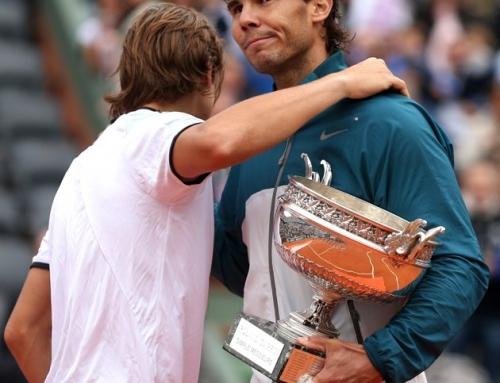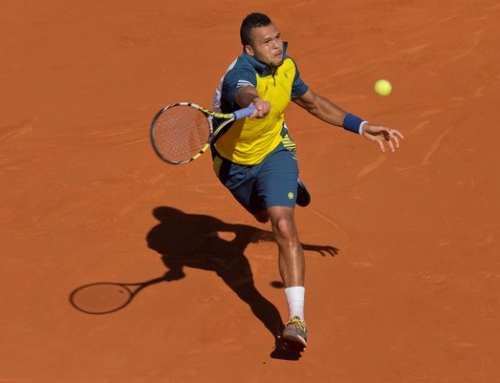Everyone’s asking whether Roger Federer has lost it. But, to me, he’s like Chris Evert when Steffi Graf rose to the top spot. Martina was number 1 or 2 and Graf was behind her. However, Evert had been champ for years and years. The women’s game still resembled Evert more than it resembled Graf and it would take years before hard hitters were the norm rather than the exception.
Federer is still good enough to beat pretty much every player regularly except the very top, which means basically Nadal and Djokovic. He is likely to split matches with Murray. Other than that, his chances of beating anyone else in the top ten is excellent. Monfils, Melzer, Ferrer, Fish, Verdasco, and on and on.
Monfils wasn’t exactly in the best shape to beat Federer after his marathon match with Ferrer, but even so, Federer plays a brand of tennis where he moves the ball around all the time. Federer isn’t interested in engaging long cross court rallies, something Ferrer is perfectly willing to do. Because of this. Federer can open up the court quickly and win points. Add to that Monfils making sometimes unwise decisions, and Federer generally had the edge in their meetings.
And so Federer goes through Monfils in straight set fashion to reach, yes, another Slam semifinals without dropping a set. Score: 6-4, 6-3, 7-6.
This leads to the biggest test Federer has had so far. Can he beat Djokovic on clay? What can he do, if anything, to shake Djokovic’s confidence. It’s really hard to hit through Djokovic. It’s not like Federer will play him like Murray played Troicki, dinking slices and off-pace shots. Federer has variety, but true finesse is not his game.
He and Paul Annacone have had plenty of time to think about how to solve the Djokovic problem. Even if he has an idea for a solution, it’s not clear it will work. Andy Roddick has a dismal record against Federer. This allowed Roddick the luxury of trying different tactics against him, but the fact is, you need some weapon that can hurt your opponent. What’s hurt Federer is that he makes too many errors and that Djokovic is now able to withstand the Federer attack. Djokovic gets a rest too because Fognini decide he couldn’t play the quarterfinal match.
Make no mistake, Federer is playing solid tennis, but this has happened to him before. Last year, when Federer played Soderling, he had not dropped a set either. To be fair, he hadn’t played a player like Monfils either, but still he was doing well.
It would be great to see Federer come up with something different. But the usual thing that happens with Federer is that he promises everything is going well in training, and when you see him play, it looks about the same as before. He hits well, shanks a few times, and so forth. You can see definable changes in Nadal’s game, in Djokovic’s game, in Murray’s game, but it’s hard to point to specifics to see changes in Federer’s game.
His biggest improvement is his backhand, but it’s still not a weapon that earns him many points. He hit a fair number of winners to win the 2010 Australian Open but that weapon did not develop the rest of 2010. He’s hitting with a bit more topspin than before, but he doesn’t seem that much more accurate than before. When Djokovic plays at his best, he has a surgical precision to where he hits. He hits winners that don’t seem all that hard. He just hits to a spot, and his opponents aren’t there to recover.
Of course, Federer has to believe he can win. He did, after all, beat Djokovic 4 of 5 times in 2010. If he does beat Djokovic, Nadal may be the one thanking Federer because Federer has to solve two problems: Djokovic and Nadal. Nothing in Federer’s play at the French shows he is ready to do both, or even either. Of course, Federer could hope that Soderling comes to his rescue once again and beats Nadal.
As the tournament winds to the finals, the intrigue level has gone up with two co-favorites, Djokovic and Nadal, and one somewhat favorite, Federer, and a potentially spoiler, most likely Soderling that could make Nadal’s life very interesting.




![[French Open] The tactics of the Djokovic-Nadal semifinals](https://www.essentialtennis.com/wp-content/uploads/2013/06/20130607nole-500x383.jpg)
![[French Open, SF] David Ferrer defeats Tsonga in straight sets to reach first Slam final](https://www.essentialtennis.com/wp-content/uploads/2013/06/20130607ferrer-500x383.jpg)
![[French Open, SF] Nadal escapes epic 5-setter with win over Djokovic, to compete for 8th title](https://www.essentialtennis.com/wp-content/uploads/2013/06/20130607rafa-500x383.jpg)
